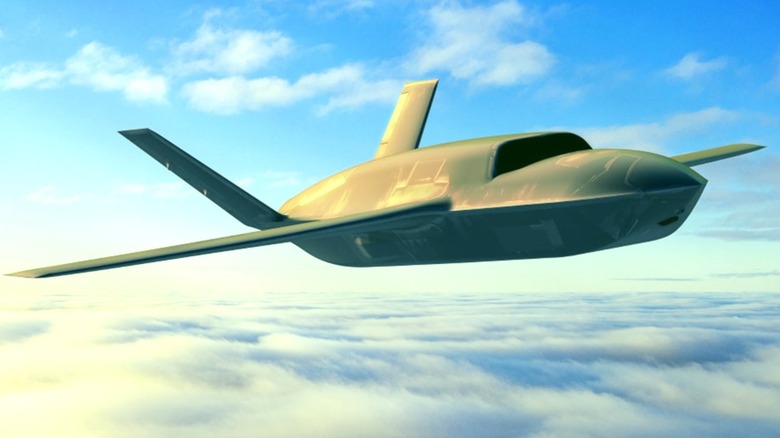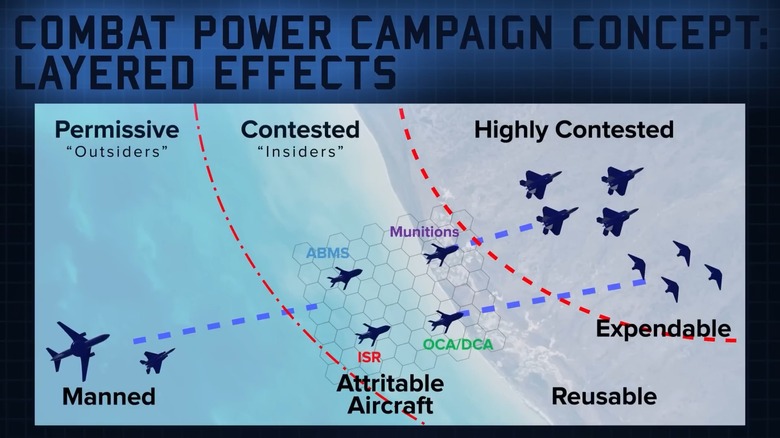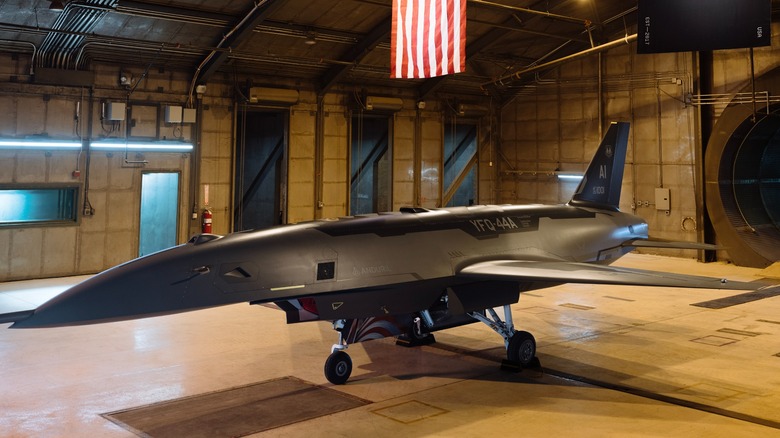What Is A Wingman Drone And How Does It Work With Fighter Jets?
Traditionally, fighter jets would fly into hostile areas with wingmen to support one another throughout an operation, but the United States and other nations are moving toward a new means of accomplishing this tactic. In the U.S., the Collaborative Combat Aircraft (CCA) program is developing specially designed combat drone wingmen to operate in tandem with crewed fighters. These drone wingmen are highly capable, semi-autonomous combat aircraft designed to fly alongside aircraft such as the F-22 Raptor and the F-35 Lightning II.
This is known as manned-unmanned teaming (MUM-T), and it represents the next step in combat aviation. In the U.S., multiple services are working on the program, and recently, the General Atomics YFQ-42 (pictured) and Anduril's YFQ-44A were selected as the U.S. Air Force's designs for the CCA, and it's being developed with the aforementioned fighters in mind, as well as the forthcoming Air Force Next Generation Air Dominance (NGAD) fighter. While flying alongside or in the vicinity of crewed aircraft, a wingman drone could perform a range of missions, including electronic warfare, surveillance, and strike operations.
Because the program is in development, multiple avenues of control are being considered; however, the program's goal is to make CCAs fully autonomous while operating alongside crewed fighters. Skyborg, the software precursor to the CCA, demonstrated the functional capability of two test MQ-20 Avengers in 2021, which flew autonomously in a coordinated fashion while responding to commands and remaining within designated geo-fences. The primary goal, aside from being a force multiplier, is to reduce the risk to human pilots while maximizing capabilities with expendable aircraft.
The future of U.S. drone warfare is the CCA
Drones and other unmanned vehicles have been used for decades, with the technology dating back to 1917. However, it took a considerable amount of time for the tech to evolve into its current form. The 21st century has already proven that drones are the future of warfare in conflicts in the Middle East and in the Russo-Ukrainian War. Still, crewed fighters aren't going anywhere anytime soon, and while AI is being integrated into multiple platforms, the goal of the CCA is to augment the combat power of traditional fighters, and the concept is coming to fruition.
Multiple models of autonomous drone wingmen are being developed around the world, and the U.S. aims to put its first into operation within only a few years. Given the speed at which development has progressed, that seems like a foregone conclusion at this point. The Air Force's new fighter drones are the way of the future and are meant to fly ahead of crewed fighters to engage targets.
This would effectively keep the crewed fighters safer, and during a mission to a contested area, a CCA could take out enemy aircraft or air defenses. Once this occurs, a crewed fighter can arrive and deliver its payload or conduct its mission in comparative safety. For this reason, CCAs are being designed with minimal maintenance and lifespans, as they're not meant to serve forever. Instead, they're intended to be expendable, and like earlier drones such as the MQ-1 Predator or MQ-9 Reaper, they can be reused for quite some time without concern for pilot safety.
The U.S. Air Force's Collaborative Combat Aircraft
The General Atomics YFQ-42 and Anduril's YFQ-44A (pictured) are still in development as of mid-2025, and there's not much information available regarding their capabilities, projected ordnance, or sensors they might carry. Some details have been revealed, including the fact that Anduril has partnered with Germany's Rheinmetall to co-produce its aircraft for European allies. General Atomics is also seeking this opportunity, so the U.S. isn't the only nation eyeing the fielding of wingman drones in the future; it seems NATO allies will also have that opportunity.
While the technical specifics and overall capabilities are currently unknown, these aircraft are being designed to operate alongside some of the fastest and most robust 5th and future 6th-generation fighters. To that end, they'll likely need to at least match something like the F-35A's speed and range capabilities. The F-35 has a cruising speed of Mach 0.86 (approximately 660 mph) and a maximum speed of Mach 1.6 (approximately 1,200 mph) with a range of 1,381 miles. It's likely they'll be armed with air-to-air missiles to engage airborne threats, but they could feasibly carry air-to-ground missiles.
Military observers have identified several visual elements of the designs and believe some of the installed sensors include a forward-facing camera system and an infrared search and track sensor (IRST). The latter makes sense, given the intended role, as IRSTs are used to locate stealthy targets, enabling a CCA's air-to-air support combat role. It's also unclear how many CCAs might fly alongside a fighter, but whatever their capabilities, it's likely that wingman drones are the future of aerial combat.


